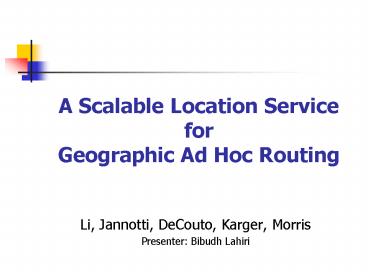A Scalable Location Service for Geographic Ad Hoc Routing
1 / 13
Title:
A Scalable Location Service for Geographic Ad Hoc Routing
Description:
Each node determines its own geographic position using GPS ... The inset squares are regions in which B will seek a location server. ... –
Number of Views:16
Avg rating:3.0/5.0
Title: A Scalable Location Service for Geographic Ad Hoc Routing
1
A Scalable Location Service forGeographic Ad Hoc
Routing
- Li, Jannotti, DeCouto, Karger, Morris
- Presenter Bibudh Lahiri
2
Organisation
- Introduction
- Geographic Forwarding
- The Grid Location Service
3
Introduction
- A distributed location service for tracking
mobile node locations - Each mobile node periodically updates a small set
of location servers with its current location
4
Geographic Forwarding
- Each node determines its own geographic position
using GPS - A node announces its presence, position, and
velocity to its neighbors by broadcasting
periodic HELLO packets - Each node maintains a table of its current
neighbors' identities and their geographic
positions - When a node needs to forward a packet toward
location P, the node consults its neighbor table
and chooses the neighbor closest to P
5
The Grid Location Service
- For a node A to contact node B, A queries the
location server for B's current location before
using geographic forwarding to contact B - A node maintains its current location
- in a number of location servers distributed
throughout the network - Each node acts as a location server on behalf of
some other nodes
6
The Grid Location Service (contd.)
- The location servers for a node are relatively
dense near the node but sparse farther from node - Anyone near a destination can use a nearby
location server to find the destination - For long distance queries, query path lengths are
proportional to data path lengths
7
The Grid Location Service (contd.)
- Deployment plane is partitioned into a hierarchy
of grids with squares of increasing size - Not every square made up of four order-n squares
is - an order-(n 1) square
A piece of the global partitioning of the world
8
The Grid Location Service (contd.)
- A particular order-n square is part of only one
order-(n 1) square - A node is located in exactly one square of each
size - Each node B knows that other nodes will want to
locate it, with little knowledge beyond B's ID - B recruits nodes with IDs "close" to its own ID
to serve as its location servers - Node closest to B in ID space is the node with
the least ID greater than B - The ID space is circular
9
The Grid Location Service (contd.)
- A node selects location servers in each sibling
of a square that contains the node - A node chooses three location servers for each
level of the grid hierarchy - In each of the three order-1 squares that, along
with B's own order-1 square, make up an order-2
square, B chooses the node closest to itself in
ID space as a server
10
The Grid Location Service (contd.)
The inset squares are regions in which B will
seek a location server. The nodes that become B's
location servers are circled and shown in bold.
11
The Grid Location Service (contd.)
- To perform a location query, A sends a request
(using geographic forwarding) to the least node
gt B for which A has location information - That node forwards the query in the same way
- Eventually, the query reaches a location server
of B which will forwards the query to B itself - Since the query contains A's location, B can
respond directly using geographic forwarding
12
The Grid Location Service (contd.)
An entire network's location server organization.
Each node is shown with the list of nodes for
which it has up to date location information B's
location servers are shown in bold. Two possible
queries by A for B's location are shown.
13
- Thank You































